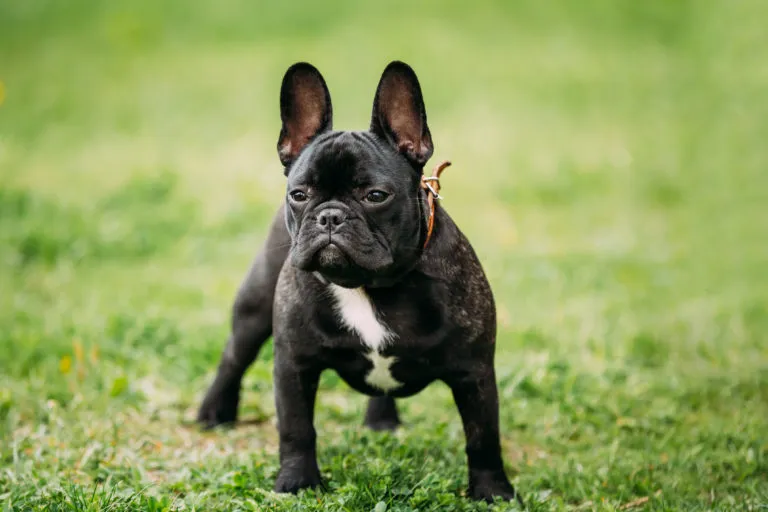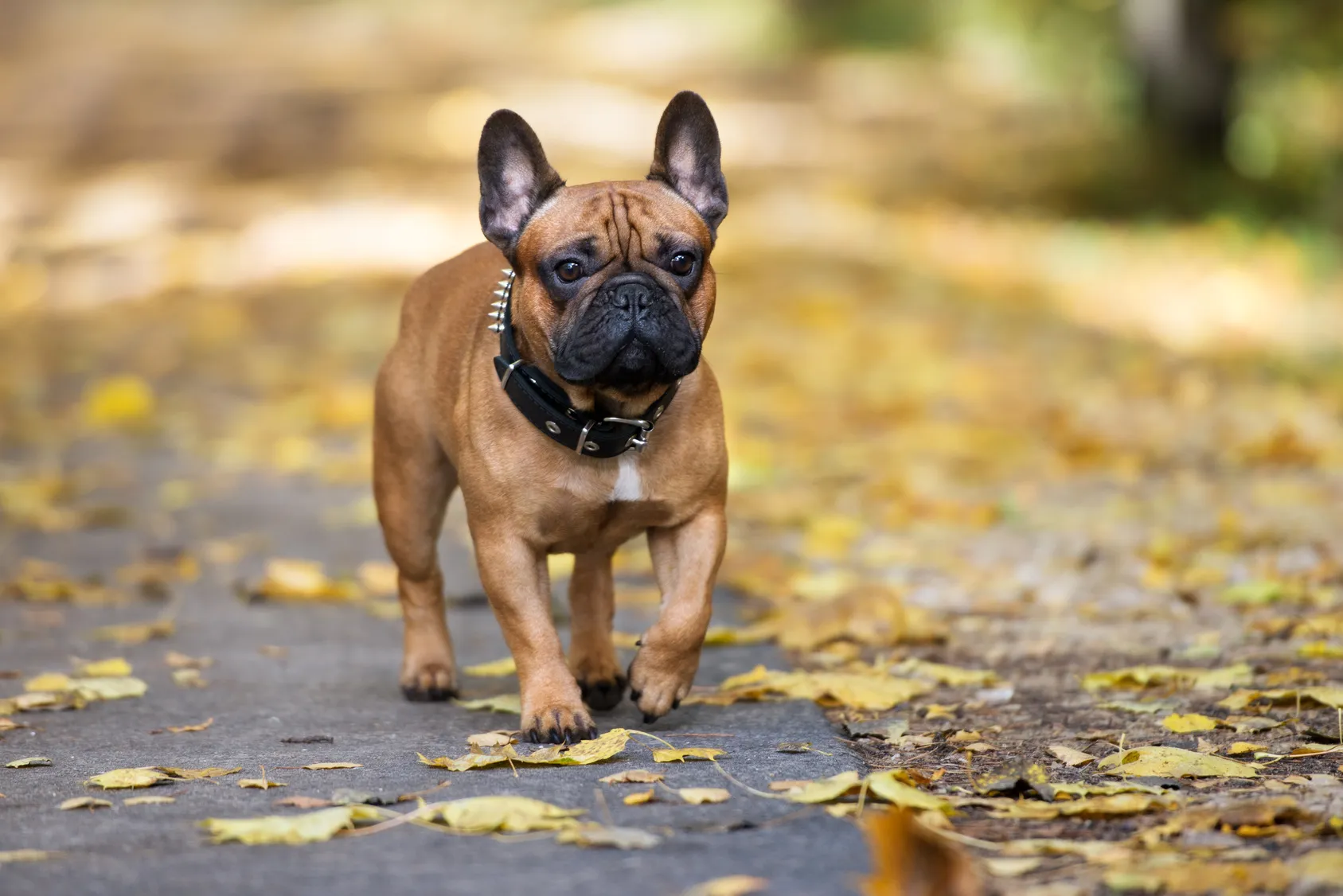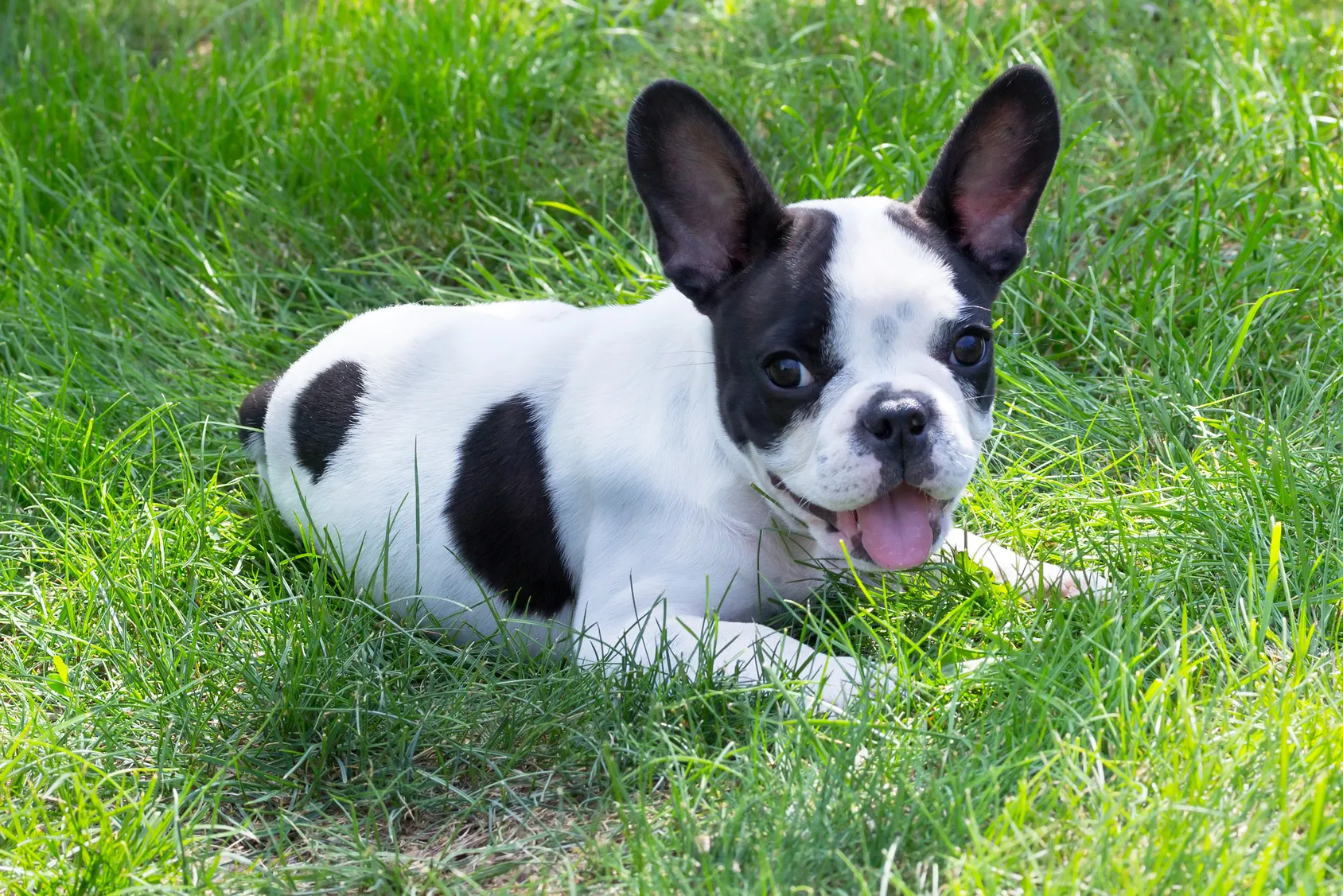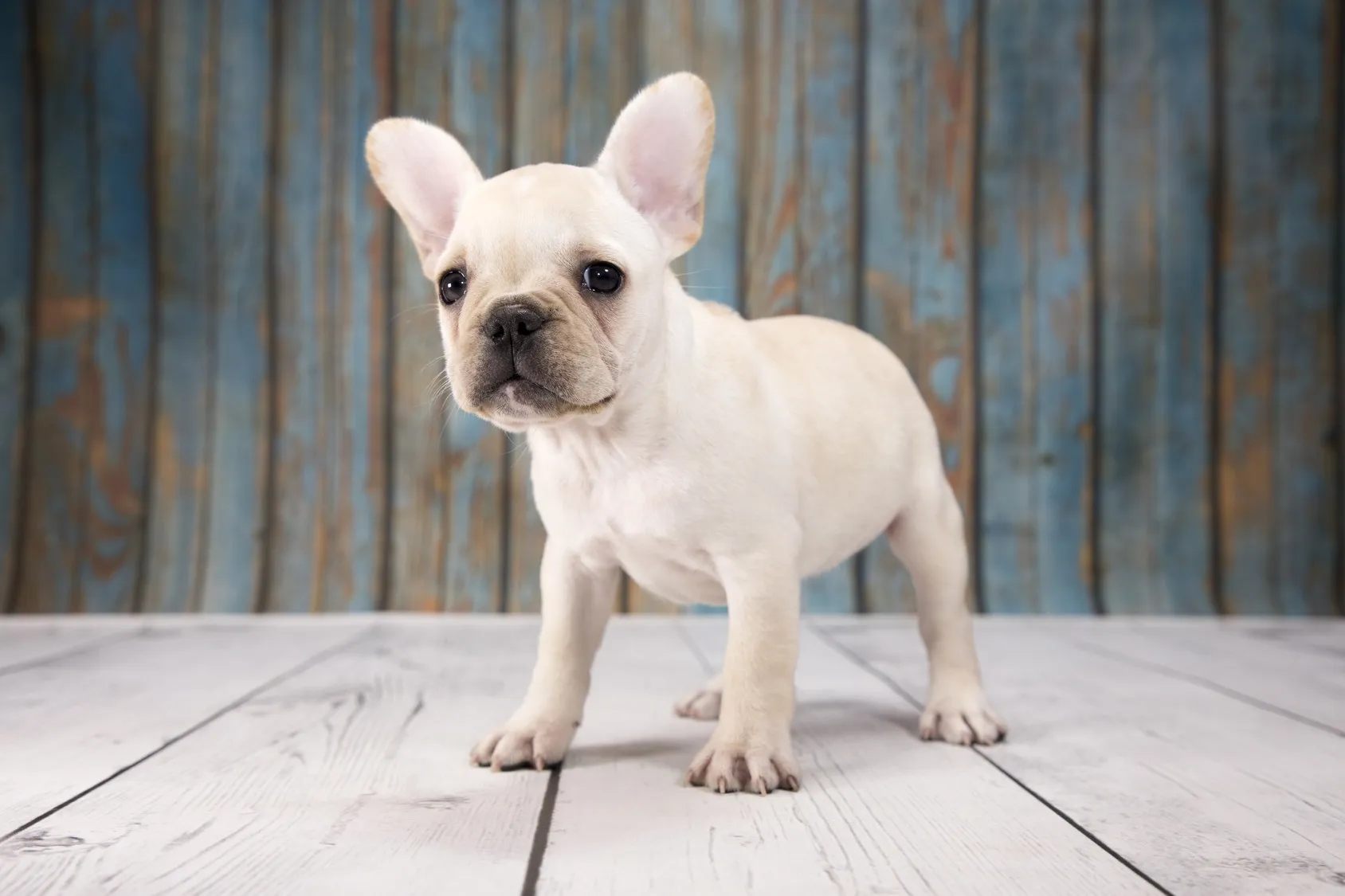Medium Size Poodle
Introducing a little charmer with bat ears! The cheerful French Bulldog is a kind breed that will quickly have its owners wrapped around its paws. These small powerhouses are muscular and compact, with a short, squat physique. The French Bulldog is around 30cm in withers height, weighing between 8-14kg. It has large, striking bat ears that stand tall above its square head, with its characteristic short snout and tail. The shiny coat has no undercoat and comes in a range of different colours, from common shades such as black or white all the way to fawn, cream or dark brindle.

© Grigory Bruev / stock.adobe.com
 © otsphoto / stock.adobe.com
© otsphoto / stock.adobe.com
The French Bulldog is a member of the Molosser family, which includes other breeds such as the Pug, the Bordeauxdog and the Mastiff. These dogs may all have the same ancestors, but the French Bulldog is in fact a very young breed, only being specifically bred in the second half of the 19th century. Dog experts are not entirely sure which breeds contributed to the modern-day French Bulldog, but it is believed that they were bred from small-statured British Bulldogs that came over from the UK with English weavers settling in Normandy. The English Bulldogs were used for dog fighting as well as, hence the name, for bullbaiting, in which a tailed bull was bitten by several dogs as entertainment. Fortunately, after these cruel fights were banned, Bulldogs instead began being bred as social dogs. In the early days of French Bulldog breeding, it is also thought that they were crossed with Terriers for a short time, as some breeders had only just discovered the breed. Pugs may also have played a part in the development of the French Bulldog.
In 1880, the first breed club was founded in Paris, with some French Bulldogs beginning to return to the UK at the end of the 19th century. They were initially judged as English Bulldogs, due to there being no specific French Bulldog breed standards, and they were mocked due to their large, bat-like ears from France. In 1888, the breed’s own standard was developed, with the most famous ancestor of the breed being “Loupi”, who features in the majority of all pedigrees. The French Bulldog became particularly popular in Paris, particularly amongst poorer dog lovers. It later became a favourite with the European nobility, thanks to its extraordinary appearance and pleasant nature. At the turn of the century there was also a brief boom in French Bulldogs in the USA. Nowadays, the “bat pig” is popular in many countries, with many celebrities enjoying the company of these delightful four-legged creatures. For example, Hugh Jackman is often seen with his two French Bulldogs Dali and Peaches, showing that this breed can be a great addition to any everyday situation, and is even happy having a snooze next to its owner working hard on an exercise machine! Even Madonna has succumbed to the bat-eared charm and has a female French Bulldog known as Gypsy Rosa Lee.
These child-loving imps have an uncomplicated, cheerful nature. The French Bulldog is smart, friendly, loves cuddles and is easy to train. They also appreciate a walk – sadly having to settle for short ones due to their shortness of breath – and rarely bark. As a rule, this breed gets on well with other dogs, being playful and attentive. These dogs are also fond of children and have very little hunting instinct, which makes them ideally suited for living with other pets and even with or next door to cats! All of these qualities combine with their size to make French Bulldogs charismatic, popular city dogs.
As with all dogs, the French Bulldog benefits from strong leadership – once this is in place, training is a piece of cake! As long as you show consistency and do not succumb to this little dog’s charms, you will quickly have this dog putting its own desires to one side and responding to basic obedience. You must not tolerate unwanted behaviour in your French Bulldog, such as not wanting to go to bed, as it will be extremely difficult to correct this behaviour at a later stage. With positive reinforcement and breaking training down into small chunks to allow for the limited attention span of a young French Bulldog, your dog will soon have mastered all the important basic commands. A dog school can also be a useful partner in training and socialising your puppy!
As uncomplicated as the French Bulldog is in nature, there are a number of health issues to keep in mind and would-be owners need to be careful to avoid breeders looking to promote the extreme short-headedness of this breed. Due to the short head shape, known as “brachycephaly”, this breed can suffer from respiratory problems and may also snore, which may be charming in a puppy but can become a real problem in a mature French Bulldog. Some can suffer with a condition known as “cherry eye”, usually developing at a young age, which can be corrected with surgery if necessary. French Bulldogs also struggle to tolerate the heat, so longer walks during the summer months are best carried out first thing in the morning or late at night. You should also be sure that your French Bulldog has a cool, shady space in which to relax away from the heat. This breed can often have sensitive eyes, so draughts should also be avoided. Natural births are also scarcely possible anatomically with French Bulldogs, due to the size of the head in relation to the pelvis. On average, you can expect a French Bulldog to live to between nine and eleven years of age.
The French Bulldog is naturally prone to excessive weight gain, which can of course be avoided using the correct diet and sufficient exercise. Some of this breed suffer with sensitive stomachs and bloating, so finding the right food can be extremely important. Once you have established a healthy diet for your sensitive French Bulldog, it is also important to avoid experimenting with food, including treats and snacks. The most suitable option is a food rich in meat, regardless of whether you choose to feed a wet or dry food diet – meat should be top of the ingredients list! You should also select a grain-free food, as these can cause serious problems for dogs with sensitive stomachs.
Young French Bulldogs should have their daily food allowance split between four meals, whilst two will suffice for adult dogs. After feeding, be sure that your dog has time to rest and digest; after a walk is an ideal meal time. When you initially bring your French Bulldog home, the breeder should provide with some of the food it is currently on, so that you can switch your puppy gradually onto whichever food you have chosen. Begin by mixing small amounts of the new food in with the previous food, gradually increasing the amount over time to avoid irritating the sensitive Bulldog stomach. Dental care snacks can be a great way to look after your dog’s oral health, as well as regularly chewing on pieces of raw beef to strengthen the jaw. However, pork should be avoided. You should also ensure that your dog always has plenty of drinking water available throughout the day.
Discover our range of specific Bulldog pet food in the zooplus shop!
 © kwiatek7 / stock.adobe.com
© kwiatek7 / stock.adobe.com
A French Bulldog’s fur is easy to care for, with a short coat that takes up little of your time. You should only wash your dog if it gets really dirty, using a mild shampoo specifically designed for dogs. A common feature in these dogs is skin wrinkles on the face, which should be cleaned regularly with a damp cloth to help prevent inflammation. You should also check regularly for dirt in the ears and clean them out when necessary. Special ear cleaners are available specifically for this job!
Being there is everything! French Bulldogs love going for walks, but not in hot weather. You should also be careful not to walk too fast or to overwhelm your dog with the length of walk. Due to its short legs, this breed is no great athlete! Many French Bulldogs also suffer with shortness of breath due to the short head shape, which can mean your dog tries to take in breath faster than it is able. Although French Bulldogs are unlikely to destroy your house whilst you are out and about, they should not be left alone for long periods of time. Keep your little dog busy by practising simple tricks that keep its brain busy but do not overwork its body. This sociable breed is also happy playing with other dogs, as well as appreciating regular cuddles. A quiet afternoon in your company will more than suffice for the French Bulldog, as long as plenty of attention is on offer!
A French Bulldog is the ideal choice for any dog lover not looking for too sporty a pet! This breed loves children and is suitable for both families and singles, as well as being a great choice for first-time dog owners. Older people who enjoy travelling with their dog will also enjoy this breed. The French Bulldog can be kept in a city apartment, although it is important that it does not have to regularly climb stairs with its little legs. They are also not ideal for anyone needing to leave their dog alone for long periods of time, as they need plenty of attention. Children can easily befriend the French Bulldog, as long as you explain the rules to them beforehand – always treat this little dog with respect and let it take a break when it needs one. If your child follows these instructions, friendships can develop that can last a lifetime! As the French Bulldog has no hunting instinct, it is generally fairly adept at socialising with other pets. Make sure no-one in the household is allergic to dogs before committing to taking one on. These charming French Bulldogs are comfortable in any kind of home, although you should check if you are allowed pets in any rental properties. Before your dog moves in, you will also need to look into pet insurance and microchipping, as well as think about what will happen to your dog when you go away or on holiday. Can your French Bulldog come with you? Search for dog-friendly hotels and destinations in advance, avoiding anywhere with too much heat. The alternative is to find kennels or a dog sitter to care for your dog whilst you are away.
The basic equipment you will need to care for a French Bulldog includes bowls, dog beds, a transport crate, kennel or harness for in the car, toys and, of course, a collar and lead, as well as a harness if possible. As well as taking all of these items into consideration, remember to factor in the ongoing cost of high-quality food and regular vet visits – these should take place at least once a year, or more frequently in case of illness.
 © rich / stock.adobe.com
© rich / stock.adobe.com
Even in dog breeding you will find that the rule of supply and demand applies. As the French Bulldog is becoming an ever more popular breed, you will find that this trend attracts more and more people merely looking to breed this dog to make a quick buck, rather than because they have any love for or interest in the breed itself. When buying a French Bulldog puppy, be sure to find a reputable breeder who is happy to answer all of your questions, even after you have taken your puppy home with you. A competent breeder will be a member of a breed association and will only sell puppies complete with pedigree paperwork, vaccination certificates and, of course, having undergone regular worming. Even if you are not looking to breed yourself in the future, you should always be sure to buy a dog with papers, as this will ensure your chosen breeder belongs to an association affiliated with the umbrella breeding associations and will have undergone various checks before breeding their dogs. A competent breeder is the best protection against genetic and hereditary diseases.
Most breeders will allow you to visit the puppy a few times in its original home, as well as letting you get to know the parent dogs. Your best option is to choose a breeder who focuses on just one breed, and be sure they let their dogs rest for a suitable amount of time between litters – quality, not quantity! The breeder should also be happy to answer any questions you may have about the breed itself and about any health care advice, including problematic breed features such as, in this case, the short head shape leading to shortness of breath. You should also expect the breeder to scrutinise you and your living situation – this is a good sign that you have chosen a responsible breeder, as it shows real concern for the future welfare of the puppies.
So, you have decided you want to offer a French Bulldog a home? Great! As well as buying directly from a breeder, there are plenty of French Bulldogs waiting to be adopted from animal shelters. It is also worth researching specialist “Bulldogs in Need” organisations that are committed to finding loving new homes for Bulldogs of all kinds. A good animal shelter will discuss with you whether a certain Bulldog’s temperament is suitable for you, your family and your home situation. Ideally, you will also be able to take a shelter dog for a few walks and outings to get to know it better before it moves into your home.
We wish you a great time with your French Bulldog!
Fans of the Bearded Collie agree that those who aren't familiar with this dog breed simply have to get acquainted with it. And those who have experienced how a Bearded Collie bolts across meadows with its flowing fur, how it rolls around full of energy and joy and how it attentively and observantly takes into account its owners wishes become simply addicted to this original dog breed and its unique charm.
The Goldendoodle isn't a breed, but a pairing between Golden Retrievers and Medium or Standard Poodles. Marketed as a low-maintenance dog for allergy sufferers, this hybrid is enjoying increasing popularity amongst dog lovers, similar to the Labradoodle.